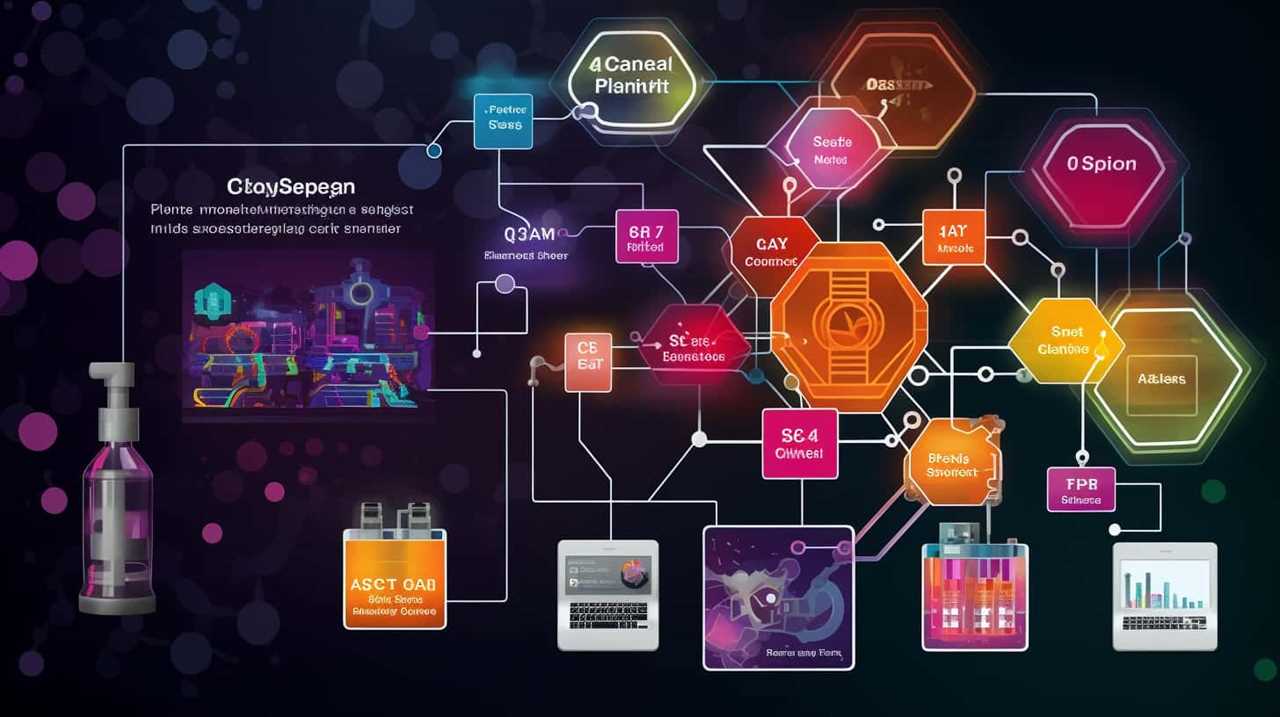It’s interesting how we are faced with the intersection of technological advancements and production challenges, isn’t it? Join us as we delve into the real struggles of incorporating AI into the manufacturing industry.
Lack of data infrastructure, resistance to change, skill gaps, cost considerations, and ethical concerns all contribute to the complex landscape.
By unlocking these challenges, we aim to provide insights into how AI can be successfully integrated, revolutionizing the manufacturing industry.
So, let’s embark on this analytical journey together and uncover the path to AI implementation in manufacturing.

Key Takeaways
- Lack of robust data infrastructure hinders AI implementation.
- Resistance to change impedes AI implementation.
- Skill gap hinders successful AI implementation.
- Conduct a cost analysis for AI implementation.
Lack of Data Infrastructure
One major challenge we face in implementing AI in manufacturing is the lack of a robust data infrastructure. Without a strong foundation for data collection, storage, and analysis, the potential of AI remains untapped.
Data security is a critical concern in the manufacturing industry, as sensitive information about processes, products, and customers must be protected from unauthorized access or breaches.
Additionally, scalability limitations hinder the efficient utilization of AI in manufacturing. The ability to handle large volumes of data and scale up operations is essential for maximizing the benefits of AI.
Overcoming these challenges requires investing in reliable data infrastructure that prioritizes data security and scalability. By addressing these issues, manufacturers can unlock the true potential of AI and revolutionize their operations.

Resistance to Change
Facing resistance to change can impede the successful implementation of AI in manufacturing. Overcoming this resistance requires addressing two key factors: employee engagement and cultural barriers.
- Employee Engagement: Ensuring that employees are actively involved in the AI implementation process can help mitigate resistance. By providing training and opportunities for skill development, employees can see the benefits of AI and feel empowered to embrace the changes. Involving them in decision-making and soliciting their feedback can also foster a sense of ownership and increase their motivation to adapt to AI technologies.
- Cultural Barriers: Cultural norms and practices within an organization can pose challenges to AI implementation. It’s crucial to promote a culture that values innovation, continuous learning, and adaptability. By addressing any existing resistance to change and encouraging open communication, leaders can create an environment where employees feel comfortable experimenting with AI technologies and are willing to embrace the changes.
Skill Gap and Workforce Training
To address the skill gap and ensure successful implementation of AI in manufacturing, we need to prioritize workforce training and development.
Upskilling initiatives and training programs play a critical role in equipping employees with the necessary knowledge and skills to effectively utilize AI technologies. These initiatives should focus on enhancing both technical and non-technical competencies.
Technical training should cover areas such as data analysis, programming, and machine learning algorithms. Non-technical training should focus on developing skills such as problem-solving, critical thinking, and adaptability.

Additionally, training programs should be tailored to the specific needs of different job roles within the manufacturing industry.
Cost and Return on Investment
To address the skill gap and ensure successful implementation of AI in manufacturing, we prioritize workforce training and development.
However, now we must consider the cost and return on investment. Conducting a cost analysis is crucial to determine the financial feasibility of implementing AI technologies.
This analysis involves evaluating the expenses associated with acquiring and implementing AI systems, such as hardware, software, and maintenance costs.

Additionally, it’s essential to assess the potential return on investment (ROI) that AI implementation can bring. AI technologies can provide a competitive advantage by improving operational efficiency, reducing downtime, and optimizing production processes.
Analyzing the expected ROI helps manufacturers make informed decisions and allocate resources effectively.
Ethical and Legal Considerations
As we delve into the realm of ethical and legal considerations, we find ourselves grappling with the complex implications of AI implementation in manufacturing.
One pressing concern is privacy. With AI systems collecting and analyzing vast amounts of data, there’s a risk of unauthorized access or misuse of sensitive information. Manufacturers must ensure robust security measures are in place to protect the privacy of individuals and the intellectual property of the organization.

Another key consideration is bias mitigation. AI algorithms are only as unbiased as the data they’re trained on. It’s crucial to address any biases in the data and algorithms to prevent discriminatory outcomes in manufacturing processes, such as hiring or resource allocation.
Ethical and legal frameworks must be established to guide AI implementation and hold manufacturers accountable for the responsible use of AI technologies.
Frequently Asked Questions
How Can the Lack of Data Infrastructure Impact the Successful Implementation of AI in Manufacturing?
The lack of data infrastructure in manufacturing can significantly impact the successful implementation of AI. Data management challenges hinder decision making, making it difficult to leverage AI’s potential for improving efficiency, productivity, and overall performance.
What Are Some Common Reasons for Resistance to Change When It Comes to Adopting AI in Manufacturing?
Resistance to change in adopting AI in manufacturing is common due to fear of job loss, lack of understanding, and operational disruption. Overcoming these obstacles requires education, clear communication, and showcasing the benefits of AI implementation.

What Steps Can Be Taken to Bridge the Skill Gap and Provide Workforce TrAIning for Employees Involved in AI Implementation in Manufacturing?
To bridge the skill gap and provide workforce training in AI implementation in manufacturing, we can start by identifying the specific skills needed, developing targeted training programs, and partnering with educational institutions and industry experts.
How Can the Cost of Implementing AI in Manufacturing Be Justified, and What Factors Contribute to the Return on Investment?
Implementing AI in manufacturing can be justified by considering the cost and ROI factors. Factors like data infrastructure impact, resistance to change, skill gap bridging, workforce training, ethical and legal considerations all play a role.
What Are Some Ethical and Legal Considerations That Manufacturers Need to Address When Implementing AI in Their Processes?
When implementing AI in manufacturing, we must consider ethical and legal aspects. Ethical considerations involve ensuring fairness, accountability, and transparency. Legal considerations include compliance with data protection laws and regulations, intellectual property rights, and liability for AI-related decisions.
Conclusion
In conclusion, the implementation of AI in manufacturing is no walk in the park. It requires a data infrastructure that’s often lacking, a workforce resistant to change, and a skill gap that needs to be bridged.

Not to mention the hefty costs and ethical considerations that come along with it.
So, if you’re thinking of diving into the AI world, be prepared to navigate through these challenges with precision and analytical thinking.
Good luck!









